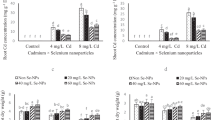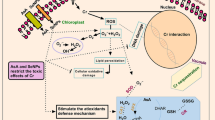Abstract
This experiment was conducted to provide a better insight into the plant responses to nitric oxide (NO) and selenium nanoparticle (nSe). Chicory seedlings were sprayed with nSe (0, 4, and 40 mg l−1), and/or NO (0 and 25 μM). NO and/or nSe4 improved shoot and root biomass by an average of 32%. The nSe40 adversely influenced shoot and root biomass (mean = 26%), exhibiting moderate toxicity partly relieved by NO. The nSe and NO treatments transcriptionally stimulated the dehydration response element B1A (DREB1A) gene (mean = 29.6-fold). At the transcriptional level, nSe4 or NO moderately upregulated phenylalanine ammonia-lyase (PAL) and hydroxycinnamoyl-CoA quinate transferase (HCT1) genes (mean = sevenfold). The nSe4 + NO, nSe40, and nSe40 + NO groups drastically induced the expression of PAL and HCT1 genes (mean = 30-fold). With a similar trend, hydroxycinnamoyl-CoA Quinate/shikimate hydroxycinnamoyl transferase (HQT1) gene was also upregulated in response to nSe and/or NO (mean = 25-fold). The activities of nitrate reductase and catalase enzymes were also induced in the nSe- and/or NO-treated seedlings. Likewise, the application of these supplements associated with an increase in ascorbate concentration (mean = 31.5%) reduced glutathione (mean = 35%). NO and/or nSe enhanced the PAL activity (mean = 36.4%) and soluble phenols (mean = 40%). The flowering was also influenced by the supplements in dose and compound dependent manner exhibiting the long-time responses. It appears that the nSe-triggered signaling can associate with a plethora of developmental, physiological, and molecular responses at least in part via the fundamental regulatory roles of transcription factors, like DREB1A as one the most significant genes for conferring tolerance in crops.






Similar content being viewed by others
References
Akram N, Iqbal M, Muhammad A, Ashraf M, Al-Qurainy F, Shafiq S (2018) Aminolevulinic acid and nitric oxide regulate oxidative defense and secondary metabolisms in canola (Brassica napus L.) under drought stress. Protoplasma 255:163–174
Andrade F, Da Silva G, Guimarães K, Barreto H, De Souza K, Guilherme L, Faquin V (2018) Selenium protects rice plants from water deficit stress. Ecotoxicol Environ Saf 164:562–570
Babajani A, Iranbakhsh A, Ardebili ZO, Eslami B (2019a) Differential growth, nutrition, physiology, and gene expression in Melissa officinalis mediated by zinc oxide and elemental selenium nanoparticles. Environ Sci Pollut Res 26:24430–24444
Babajani A, Iranbakhsh A, Ardebili ZO, Eslami B (2019b) Seed priming with non-thermal plasma modified plant reactions to selenium or zinc oxide nanoparticles: cold plasma as a novel emerging tool for plant science. Plasma Chem Plasma Process 39:21–34
Balotf S, Islam S, Kavoosi G, Kholdebarin B, Juhasz A, Ma W (2018) How exogenous nitric oxide regulates nitrogen assimilation in wheat seedlings under different nitrogen sources and levels. PLoS One 13:e0190269. https://doi.org/10.1371/journal.pone.0190269
Beaudoin-Eagan LD, Thorpe TA (1985) Tyrosine and phenylalanine ammonia-lyase activities during shoot initiation in tobacco callus cultures. Plant Physiol 78:438–441
Bhalani H, Thankappan R, Mishra GP, Sarkar T, Bosamia TC, Dobaria J (2019) Regulation of antioxidant mechanisms by AtDREB1A improves soil-moisture deficit stress tolerance in transgenic peanut (Arachis hypogaea L.). PLoS One 14:e0216706. https://doi.org/10.1371/journal.pone.0216706
Bian Z, Bo L, Cheng R, Yu W, Tao L, Yang Q (2020) Selenium distribution and nitrate metabolism in hydroponic lettuce (Lactuca sativa L.): effects of selenium forms and light spectra. J Integr Agric 19:133–144. https://doi.org/10.1371/journal.pone.0216706
Cao D, Liu Y, Ma L, Jin X, Guo G, Tan R, Liu Z, Zheng L, Ye F, Liu W (2018) Transcriptome analysis of differentially expressed genes involved in selenium accumulation in tea plant (Camellia sinensis). PLoS One 13:6
Dai Z, Rizwan M, Gao F, Yuan Y, Huang H, Hossain M, Xiong S, Cao M, Liu Y, Tu S (2020) Nitric oxide alleviates selenium toxicity in rice by regulating antioxidation, selenium uptake, speciation and gene expression. Environ Pollut 257:113540
Djanaguiraman M, Belliraj N, Bossmann SH, Prasad PV (2018) High-temperature stress alleviation by selenium nanoparticle treatment in grain sorghum. ACS Omega 3:2479–2491
Donde R, Gupta M, Gouda G, Kumar J, Vadde R, Sahoo K, Dash S, Behera L (2019) Computational characterization of structural and functional roles of DREB1A, DREB1B and DREB1C in enhancing cold tolerance in rice plant. Amino Acids 51:839–853. https://doi.org/10.1007/s00726-019-02727-0
Elansary HO, Abdel-Hamid AM, Yessoufou K, Al-Mana FA, El-Ansary DO, Mahmoud EA, Al-Yafrasi MA (2020) Physiological and molecular characterization of water-stressed Chrysanthemum under robinin and chitosan treatment. Acta Physiol Plant 42:31
Feigl G, Horváth E, Molnár Á, Oláh D, Poór P, Kolbert Z (2019) Ethylene-nitric oxide interplay during selenium-induced lateral root emergence in Arabidopsis. J Plant Growth Regul 38:1481–1488
Ghasempour M, Iranbakhsh A, Ebadi M, Ardebili ZO (2019) Multi-walled carbon nanotubes improved growth, anatomy, physiology, secondary metabolism, and callus performance in Catharanthus roseus: an in vitro study. 3 Biotech 9(11):404
Hajiboland R, Rahmat S, Zeinalzadeh N, Farsad-Akhtar N, Hosseinpour-Feizi MA (2019) Senescence is delayed by selenium in oilseed rape plants. J Trace Elem Med Biol 55:96–106
Handa N, Kohli SK, Sharma A, Thukral AK, Bhardwaj R, AbdoAllah EF, Alqarawi A, Ahmad P (2019) Selenium modulates dynamics of antioxidative defence expression, photosynthetic attributes and secondary metabolites to mitigate chromium toxicity in Brassica juncea L. plants. Environ Exp Bot 161:180–192
Hu T, Li H, Li J, Zhao G, Wu W, Liu L, Wang Q, Guo Y (2018) Absorption and bio-transformation of selenium nanoparticles by wheat seedlings (Triticum aestivum L.). Front Plant Sci 9:597
Huang J, Wei H, Li L, Yu S (2018) Transcriptome analysis of nitric oxide-responsive genes in upland cotton (Gossypium hirsutum). PLoS ONE 13(3):e0192367
Hussain A, Mun BG, Imran QM, Lee SU, Adamu TA, Shahid M, Kim KM, Yun BW (2016) Nitric oxide mediated transcriptome profiling reveals activation of multiple regulatory pathways in Arabidopsis thaliana. Front Plant Sci 7:975
Hussein H, Darwesh OM, Mekki B (2019) Environmentally friendly nano-selenium to improve antioxidant system and growth of groundnut cultivars under sandy soil conditions. Biocatal Agric Biotechnol 18:101080
Imran QM, Hussain A, Lee SU, Mun BG, Falak N, Loake GJ, Yun BW (2018) Transcriptome profile of NO-induced Arabidopsis transcription factor genes suggests their putative regulatory role in multiple biological processes. Sci Rep 8:771. https://doi.org/10.1038/s41598-017-18850-5
Iranbakhsh A, Ardebili ZO, Molaei H, Ardebili NO, Amini M (2020) Cold plasma up-regulated expressions of WRKY1 transcription factor and genes involved in biosynthesis of cannabinoids in Hemp (Cannabis sativa L.). Plasma Chem Plasma Process 40:527–537. https://doi.org/10.1007/s11090-020-10058-2
Jiang L, Yang J, Liu C, Chen Z, Yao Z, Cao S (2020) Overexpression of ethylene response factor ERF96 gene enhances selenium tolerance in Arabidopsis. Plant Physiol Biochem 149:294–300
Khattab HI, Emam MA, Emam MM, Helal NM, Mohamed MR (2014) Effect of selenium and silicon on transcription factors NAC5 and DREB2A involved in drought-responsive gene expression in rice. Biol Plant 58:265–273
Khoshbakht D, Asghari MR, Haghighi M (2018) Effects of foliar applications of nitric oxide and spermidine on chlorophyll fluorescence, photosynthesis and antioxidant enzyme activities of citrus seedlings under salinity stress. Photosynthetica 56:1313–1325
Kohan-Baghkheirati E, Bagherieh-Najjar M, Abdolzadeh A, Geisler-Lee J (2018) Altered DREB1A gene expression in Arabidopsis thaliana leads to change in root growth, antioxidant enzymes activity, and response to salinity but not to cold. J Genet Resour 4:90–104
Kudo M, Kidokoro S, Yoshida T, Mizoi J, Todaka D, Fernie AR, Shinozaki K, Yamaguchi-Shinozaki K (2017) Double overexpression of DREB and PIF transcription factors improves drought stress tolerance and cell elongation in transgenic plants. Plant Biotechnol J 15:458–471
Legrand G, Delporte M, Khelifi C, Harant A, Vuylsteker C, Mörchen M, Hance P, Hilbert JL, Gagneul D (2016) Identification and characterization of five BAHD acyltransferases involved in hydroxycinnamoyl ester metabolism in chicory. Front Plant Sci 7:741
Majeed S, Nawaz F, Naeem M, Ashraf MY (2018) Effect of exogenous nitric oxide on sulfur and nitrate assimilation pathway enzymes in maize (Zea mays L.) under drought stress. Acta Physiol Plant 40:206
Moghanloo M, Iranbakhsh A, Ebadi M, Ardebili ZO (2019a) Differential physiology and expression of phenylalanine ammonia lyase (PAL) and universal stress protein (USP) in the endangered species Astragalus fridae following seed priming with cold plasma and manipulation of culture medium with silica nanoparticles. 3 Biotech 9:288
Moghanloo M, Iranbakhsh A, Ebadi M, Satari TN, Ardebili ZO (2019b) Seed priming with cold plasma and supplementation of culture medium with silicon nanoparticle modified growth, physiology, and anatomy in Astragalus fridae as an endangered species. Acta Physiol Plant 41:54
Munawar A, Akram NA, Ahmad A, Ashraf M (2019) Nitric oxide regulates oxidative defense system, key metabolites and growth of broccoli (Brassica oleracea L.) plants under water limited conditions. Sci Hortic 254:7–13
Nabi R, Tayade R, Hussain A, Kulkarni KP, Imran QM, Mun B, Yun BW (2019) Nitric oxide regulates plant responses to drought, salinity, and heavy metal stress. Environ Exp Bot 161:120–133
Nazerieh H, Oraghi Ardebili Z, Iranbakhsh A (2018) Potential benefits and toxicity of nanoselenium and nitric oxide in peppermint. Acta Agric Slov 111:357–368
Pandey P, Singh J, Achary V, Reddy M (2015) Redox homeostasis via gene families of ascorbate-glutathione pathway. Front Environ Sci 3:25
Quiterio-Gutiérrez T, Ortega-Ortiz H, Cadenas-Pliego G, Hernández-Fuentes AD, Sandoval-Rangel A, Benavides-Mendoza A, Cabrera-De La Fuente M, Juárez-Maldonado A (2019) The application of selenium and copper nanoparticles modifies the biochemical responses of tomato plants under stress by Alternaria solani. Int J Mol Sci 20(8):1950
Rajaee S, Iranbakhsh A, Ebadi M, Majd A, Ardebili ZO (2020) Red elemental selenium nanoparticles mediated substantial variations in growth, tissue differentiation, metabolism, gene transcription, epigenetic cytosine DNA methylation, and callogenesis in bitter melon (Momordica charantia); an invitro experiment. PLoS One 15(7):e0235556
Safari M, Ardebili ZO, Iranbakhsh A (2018) Selenium nano-particle induced alterations in expression patterns of heat shock factor A4A(HSFA4A), and high molecular weight glutenin subunit 1Bx (Glu-1Bx) and enhanced nitrate reductase activity in wheat (Triticum aestivum L.). Acta Physiol Plant 40:117
Santisree P, Bhatnagar-Mathur P, Sharma K (2018) Molecular insights into the functional role of nitric oxide (NO) as a signal for plant responses in chickpea. Funct Plant Biol 45:267–283
Seddighinia FS, Iranbakhsh A, Ardebili ZO, Satari TN, Soleimanpour S (2020) Seed priming with cold plasma and multi-walled carbon nanotubes modified growth, tissue differentiation, anatomy, and yield in bitter melon (Momordica charantia). J Plant Growth Regul 39:87–98. https://doi.org/10.1007/s00344-019-09965-2
Sheteiwy MS, An J, Yin M, Jia X, Guan Y, He F, Hu J (2019) Cold plasma treatment and exogenous salicylic acid priming enhances salinity tolerance of Oryza sativa seedlings. Protoplasma 256:79–99
Soleymanzadeh R, Iranbakhsh A, Habibi G, Ardebili ZO (2020) Selenium nanoparticle protected strawberry against salt stress through modifications in salicylic acid, ion homeostasis, antioxidant machinery, and photosynthesis performance. Acta Biol Cracov Ser Bot. https://doi.org/10.24425/abcsb.2019.127751
Sotoodehnia-Korani S, Iranbakhsh A, Ebadi M, Majd A, Ardebili ZO (2020) Selenium nanoparticles induced variations in growth, morphology, anatomy, biochemistry, gene expression, and epigenetic DNA methylation in Capsicum annuum; an in vitro study. Environ Pollut 5:114727. https://doi.org/10.1016/j.envpol.2020.114727
Tamaoki M, Maruyama-Nakashita A (2017) Molecular mechanisms of selenium responses and resistance in plants. In: Selenium in plants. Springer, Cham, pp 35-51
Tejada-Jimenez M, Llamas A, Galván A, Fernández E (2019) Role of nitrate reductase in NO production in photosynthetic eukaryotes. Plants 8:56
Van Hoewyk D, Takahashi H, Inoue E, Hess A, Tamaoki M, Pilon-Smits EA (2008) Transcriptome analyses give insights into selenium-stress responses and selenium tolerance mechanisms in Arabidopsis. Physiol Plant 132:236–253
Xu L, Li F, Han L, Song G, Zhang X (2017) Overexpression of Arabidopsis DREB1A gene in transgenic Poa pratensis: Impacts on osmotic adjustment and hormone metabolism under drought. Int Turf Soc Res J 13:527–36
Zahedi SM, Abdelrahman M, Hosseini MS, Hoveizeh NF, Tran LSP (2019) Alleviation of the effect of salinity on growth and yield of strawberry by foliar spray of selenium-nanoparticles. Environ Pollut 253:246–258
Author information
Authors and Affiliations
Corresponding author
Additional information
Responsible Editor: Gangrong Shi
Publisher’s note
Springer Nature remains neutral with regard to jurisdictional claims in published maps and institutional affiliations.
Rights and permissions
About this article
Cite this article
Abedi, S., Iranbakhsh, A., Oraghi Ardebili, Z. et al. Nitric oxide and selenium nanoparticles confer changes in growth, metabolism, antioxidant machinery, gene expression, and flowering in chicory (Cichorium intybus L.): potential benefits and risk assessment. Environ Sci Pollut Res 28, 3136–3148 (2021). https://doi.org/10.1007/s11356-020-10706-2
Received:
Accepted:
Published:
Issue Date:
DOI: https://doi.org/10.1007/s11356-020-10706-2




